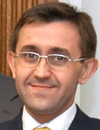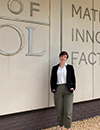08:00 | Morning Coffee and Networking in the Exhibit Hall |
|
Session Title: 3D-Printing and Microfluidics -- Joint Session of the Two Tracks |
| |
|
Session Chairperson: Professor Noah Malmstadt |
| |
08:30 | ML-Assisted in situ monitoring of Flow Reactions for Sustainable Solvent Design
Noah Malmstadt, Professor, Mork Family Dept. of Chemical Engineering & Materials Science, University of Southern California, United States of America
The transition to a sustainable chemical manufacturing infrastructure requires a new approach to solvents: solvent waste must be recycled to reactor feed, closing the material cycle. Ionic liquid (IL) solvents represent a special class of low-volatility, generally safe solvents that are particularly easy to recycle. Recent work from our lab has demonstrated that automated millifluidic flow chemistry routes to IL recycling can reduce their total process cost to the point where they are competitive with traditional volatile organic solvents.
This talk discusses an exemplary application of IL solvents: the fabrication of colloidal catalyst nanoparticles (NPs). While the capacity to produce metallic NPs in ILs has been known for decades, we know little about the mechanism of these reactions and, in particular, how solvent choice can guide this mechanism. To discover the mechanism of Pt NP fabrication in ILs, we have constructed a flow reactor with in-line spectrophotometric monitoring of the products. To determine reaction component concentration from the complex spectral data, we have implemented a machine learning (ML) algorithm that can determine concentration. By measuring product concentration as a function of residence time, we are able to determine the IL solvent-dependent reaction kinetics. |
09:00 |  | Keynote Presentation Microfluidic Approaches for the Controlled Synthesis of Particles
Simon Kuhn, Professor, Department of Chemical Engineering, KU Leuven Belgium, Belgium
Microfluidic flow reactors offer several advantages compared to conventional batch reactors, such as improved control, increased performance, and enhanced process safety. The integration of crystallization in these devices has remained difficult, as crystals tend to clog the flow channels. Both active (with an externally applied force, e.g. ultrasound) and passive methods (without external forces, e.g. multiphase flow) have been proposed to tackle this issue. Many crystallization processes rely on the addition of seeds to induce secondary nucleation. Seeding in continuous microfluidic reactors is rarely done, as the seeds are continuously flushed out and the clogging susceptibility increases. This contribution presents a seeded microfluidic nucleation section which can be used for continuous cooling crystallization. The performance of the off-line continuous seeding platform is established via the seed delivery efficiency, a measure for the seed transport through the seeding module, for constant and oscillatory flows. Second, the yields of seeded and unseeded crystallization are evaluated in the presence and absence of microbubbles. A statistically significant increase in the net yield was obtained when comparing unseeded and seeded crystallization, which can be attributed to the increased nucleation rates because of secondary nucleation. It is shown that also in the presence of seeds, the addition of microbubbles increases the productivity. Advancing to zeolite synthesis, a seeded milli-fluidic crystallizer is developed, which also features low frequency ultrasound integration, which is known to speed up crystallization kinetics during the synthesis thanks to the formation and collapse of cavitation bubbles, creation of local hotspots, intense mixing and enhanced dissolution of the amorphous species, which shorten induction time and increase growth rate. This system enables to compare the synthesis conditions in batch, silent and sonicated, and in continuous, silent and sonicated, in terms of residence time, crystallinity, and solid yield. Secondly, the change in the product characteristics, such as morphology, crystal size and crystal size distribution, pore size and its distribution in the framework is characterized. This work provides valuable insights into the design and operation of continuous crystallization processes. |
|
09:30 |  Dilase 3D: Combining Very High Resolution and Large Size Fabrication Capability Dilase 3D: Combining Very High Resolution and Large Size Fabrication Capability
Pierre Blanchet, R&D Equipment Manager, Kloé
Over the last 15 years, Kloé company developed a complete range of equipment dedicated to UV lithography applications, in perfect agreement with the microfabrication requirements in Microfluidics. Thus, Kloé company did the bet, in the early 2000, that the development of researches and industry in Microfluidics would rapidly grow. So that, over the same time, Kloé company continuously followed and exchanged with the Microfluidics community to first well understand and then anticipate its needs in terms of microfabrication techniques and performance, in order to enable fabricating from simple to more demanding microfluidic chips like Lab on a Chip / Organ on a Chip. Among a very large range of 12 different machines, covering from soft lithography / masking systems to very high resolution direct laser writers particularly suitable for fast prototyping, high aspect ratio as well as thick layers laser processing, Kloe introduces one of its latest innovations that is Dilase3D : a 3D-Printer specifically developed to meet the expectations for 3D-printing in Microfluidics. Typically elaborated from the specifications of researches in Microfluidics and Medical Sciences, that were looking for one tool enabling to both fabricate large volume pieces, but still with very high-resolution patterning capabilities, this equipment also demonstrated more recently its capability to combine different materials for the fabrication of one piece/object, that multiplies its capabilities to fabricate very demanding and ever more complex microchips/microstructures. This way, we ensure our partners to benefit from the one of the most performing and cost-effective 3D-printing solutions in that domain, in agreement with their expected level of performance and their available budget.
|
10:00 | The Development and Use of 3D Printed Reactors in Flow and Photoflow Chemistry and the Collaborative Photoflow System – the Proteus Aether
Stephen Hilton, Associate Professor, University College London School of Pharmacy, United Kingdom
In this talk we will describe our research into 3D printing and our research into the applications of various 3D printed reactors in flow chemistry, flow electrochemistry and flow photochemistry. We will also describe research from other groups into their use across a range of chemistry examples, demonstrating how the use of these low-cost reactors can make flow chemistry more accessible and reduce the barrier to entry for chemists in this key technology. As part of our research into 3D printing, we will also describe our research into the Proteus Aether – a low cost 3D printed continuous flow system designed to make photoflow chemistry more accessible and accurate, with digital telemetry and its use by others. |
10:30 | Mid-Morning Coffee Break and Networking in the Exhibit Hall |
11:00 | In-Flow Screening of Immobilized Photocatalysts in 3D Printed Microreactors
Anca Roibu, Postdoctoral Fellow, Transilvania University of Brasov, Romania
Flow microreactors are promising devices for screening photocatalyst activity due to reaction times in the range of minutes compared to several hours in conventional photoreactors and the ease of connection to inline analytical techniques. A microfluidic platform which consists of parallel microreactors and a rotating multi-wavelength LED light source was developed and its operation was automated. The microreactors were manufactured by 3D printing, the photocatalysts were immobilized as thin films, and the photocatalytic activity was investigated by applying successively various illumination conditions. The microfluidic platform was used for screening the activity of TiO2-based photocatalysts for degrading organic pollutants (e.g. imidacloprid, phenol). |
11:30 |  ASIGA Advancing 3D Printed Microfluidics ASIGA Advancing 3D Printed Microfluidics
Stephan Weiß, Global Technology Manager, ASIGA
ASIGA is a leader in reliable and precise DLP 3D Printers. In this talk we will show you how to leverage our open material system and voxel-level control over all parameters in our 3D printers to create cutting edge Microfluidic Chips.
|
12:00 |  Can Microfluidics be Truly User-Friendly? Can Microfluidics be Truly User-Friendly?
Camila Betterelli Giuliano, Microfluidics Innovation Specialist, Microfluidics Innovation Center
Microfluidics is said to become the backbone of the bio-revolution. Yet, the highest reported barrier to adoption of the technology is its complex usability. Let’s be honest, biology is already complex enough. So, how can we expect researchers to harvest the microfluidic power of new in vitro models if they don’t have the headspace to assemble Lego-like setups? Enough with the meters of tubing and million connectors, come see how design is meeting science.
|
12:30 |  A User-Centric Odyssey into Cutting-Edge Technique A User-Centric Odyssey into Cutting-Edge Technique
Victor Morel Cahoreau, Head of Sales, Eden Microfluidics
Eden Tech is a French company providing microfluidics solutions at each process step. In this talk, we will overview how to make microfluidic easier and faster.
|
13:00 | Networking Buffet Lunch in the Exhibit Hall -- Networking with Colleagues, Engage with Exhibitors, View Posters |
|
Session Chair: Professor Paul Watts |
| |
14:00 | Copper-Catalyzed Continuous-Flow Transfer Hydrogenation In Ethylene Glycol
Katia Martina, Associate Professor of Organic Chemistry, Università degli Studi di Torino, Italy
Conventional protocols are increasingly being replaced by new efficient synthetic processes that use safer chemicals, naturally abundant solvents, atom economy and efficient catalytic systems to yield the desired product with sustainability, scalability and high chemical efficiency. Flow approaches have been demonstrated to show great merit in safety and speed, as well as in their increased yields and quality. Given the importance of this process in both industry and academia, it is not surprising that a vast number of catalytic flow-chemistry hydrogenation protocols have been reported over the last decade with noble metals and that reductions of nitro benzene to aniline and alkyne to alkenes are largely studied. Non-noble metals have also been of great interest to the scientific community due to their economic and environmental advantages. The preparation of a robust supported catalyst that is made up of copper nanoparticles on celite for the selective transfer hydrogenation under continuous flow of nitroarenes and alkynes will be presented. The method is efficient and environmentally benign thanks to the absence of hydrogen gas and precious metals. Long-term stability studies show that the catalytic system is able to achieve very high conversion (> 99%) when working for long time. The versatility of the transfer hydrogenation system has been tested using representative examples with moderate-to-excellent yields being obtained. |
14:30 | From Improving Known Reactions to the Discovery of New Reactivity Exploiting Flow
Marcus Baumann, Assistant Professor, School of Chemistry, University College Dublin, Ireland
Through reactor miniaturization flow chemistry offers superb control over reaction conditions and thus lends itself towards the safe generation and immediate consumption of high-energy intermediates that would not be viable in analogous batch reactions. Our group1-5 and others have exploited this advantage to improve both the yield and selectivity of a number of synthetically important transformations. This talk will showcase several flow reactions including lithiations and photochemical processes that demonstrate the value of flow in this context, for instance for the generation and use of benzynes, acyl radicals and [1.1.1]propellane. The discovery of new chemical space aid by flow synthesis will be discussed as well. |
15:00 | Flow Biocatalysis for the Synthesis of Natural Compounds
Martina Letizia Contente, Tenure-Track Assistant Professor, University of Milan, Italy
Due to healthy life style of modern society, the preference for bio-compounds derived from natural sources is rapidly expanding. On the other hand, according with both European and US regulation (EMA and FDA) processing natural starting material with biocatalytic approaches let the commercialization of the final product as natural too, thus increasing its market value. In this scenario, the combination of biocatalysts, (whole cells and cell-free enzymes) with flow facilities, represents an emerging technology to enhance reaction productivity and sustainability. Through immobilization techniques the biocatalysts can be easily integrated in flow chemistry reactors, while their stability under operational conditions is dramatically improved. Moreover, due to the catalyst recovery and reuse for several reaction cycles cost-effective processes can be developed. Valuable natural molecules such as aroma-compounds, potent antioxidants as well as bioactive molecules have been successfully prepared merging the advantages of flow reactors with the specificity and benign conditions of biocatalysts. This strategy representing an alternative route for natural compound production in addition to plant extraction, and promoting a responsible care of natural resources is extremely attractive for a series sectors in particular food, pharmaceutical and cosmetic industries. |
15:30 | Mid-Afternoon Coffee Break and Networking in the Exhibit Hall |
16:00 | Flow Chemistry and Biomass Valorization - An Emerging Green Technology
Christophe Len, Professor, Chimie ParisTech, CNRS, France
The principles of sustainable development, bio-economy and circular economy are gaining ground in the synthesis of industrially important molecules. Furfural, glycerol and derivatives, which serve as central platform molecules, are the subject of various research efforts aimed at optimizing their conversion for the synthesis of valuable compounds. In line with the prevailing push for green chemistry and sustainable development, chemists have recently been at the forefront of innovative catalytic reactions using continuous flow processes combined or not with alternative technologies such as microwave, ultrasound, ball milling…. This progressive shift underscores a commitment to advancing environmentally friendly practices in the field of chemical synthesis. This study presents recent breakthroughs in the continuous production of bio-based chemicals derived from furfural, glycerol and derivatives. These intermediates and target chemicals are synthesized from biomass or carbohydrates using both homogeneous and heterogeneous catalysts. Various reaction parameters, including temperature, catalyst and feedstock loadings, and solvent types, have been meticulously optimized over time. The design, synthesis, and physicochemical properties of these derivatives are comprehensively elucidated. |
16:30 | Pragmatic Continuous Flow Solutions for Larger Scale Synthesis Reactions
Floris Rutjes, Professor, Institute for Molecules and Materials, Radboud University, Netherlands
This presentation will highlight some recent examples of continuous flow chemistry that were developed to solve synthetic challenges in the corresponding batch reactions, including separation of E- and Z-isomers, synthesis of complex sialic acids and determination of reaction kinetics. |
17:00 | Automated Cu(II) Monitoring over a Wide Concentration Range with Microflow Injection Analysis System Employing Modular 3D-Printed Platforms
David Ricart Fort, PhD Student, Escola Politècnica Superior d'Enginyeria de Manresa (EPSEM), Spain
An automated microflow injection analysis (microFIA) system has been developed for continuous monitoring of Cu(II) in a bioreactor using a colorimetric method. The system combines different 3D printed modules. The reagents used are hydroxylamine and neocuproine.
|
17:30 | Combining (photo)Biocatalysis with Continuous Flow: Efficient Biotransformations in 3D Printed Reactors
Heidrun Gruber-Wölfler, Associate Professor, Graz University of Technology, Austria
Biocatalysis has gained a lot of popularity in recent years as an eco-friendly alternative to conventional catalysis in synthetic chemistry. Enzymes have a variety of advantages, including as low toxicity, little environmental effect, high activity in moderate settings, and good selectivity. Nevertheless, new and innovative approaches are still required in order to increase the stability of biocatalysts and make biocatalytic processes in continuous flow commercially feasible. In this contribution the design of continuous, inexpensive, and stable biocatalytic processes for a more sustainable synthesis of fine chemicals will be discussed. In the first part, the design of a continuous automated process to evaluate the efficiency of the model enzyme PAD (phenolic acid decarboxylase) covalently immobilized on 3D printed supports [1] will be presented. For a Design of Experiments (DoE) evaluation, an automated control setup was operated by a Python-based application in order to quickly identify the optimal operating conditions and increase the level of process understanding.
The second part of the presentation will cover the construction and optimization of photo-bioreactors for carrying out light-driven biotransformations in recombinant cyanobacteria [2]. In particular, the stereoselective reduction of 2-methyl maleimide was investigated via a design-of-experiments approach.
Lastly, the combination of photo- and biocatalysis will be presented for a multistep flow process including an a-CF3-substituted ketone production in a self-made photoreactor, followed by an enzymatic ketoreduction catalyzed by an ADH-Lica (alcohol dehydrogenase) enzyme to obtain chiral trifluoromethylated alcohols.
Overall, our approaches successfully bridge well-established technologies in chemical engineering (such as additive manufacturing, process automation and optimization) with biotechnology (e.g. enzyme immobilization) and continuous flow to design more sustainable synthetic routes for fine chemicals and APIs.
[1] A. Valotta, M. C. Maier, S. Soritz, M. Pauritsch, M. Koenig, D. Brouczek, M. Schwentenwein, H. Gruber-Woelfler, J Flow Chem 2021, 11, 675–689
[2] A. Valotta, L. Malihan-Yap, K. Hinteregger, R. Kourist, H. Gruber-Woelfler, ChemSusChem. 2022, 15, e202201468 |
18:00 | Flow Enabled Synthesis of Multiresistant Drug Clofazimine
Rajat Pandey, Postdoctoral Fellow, Nelson Mandela University, South Africa
Drug resistance to tuberculosis is still one of the significant challenges worldwide. Clofazimine, which belongs to the riminophenazine (anti-biotic) class, is still one of the active drugs that are efficient against drug resistance M. Tuberculosis. Apart from this, it is also a WHO-approved drug for the treatment of leprosy (Hansen's Disease) and, at present, is under phase 2 clinical trial for its activity against the SARS-CoV-2 virus. Owing to its vast importance in clinical research, we have developed a continuous-flow mediated synthesis of clofazimine using readily available p-chloroaniline and 1-fluro-2-nitrobenzene. The target drug molecule was obtained from four consecutive chemical transformations with nominal reaction time and improved purity and yields when compared to the batch process. Moreover, the first two steps were also successfully telescoped under optimized reaction conditions. |
18:30 | Close of Summit |













